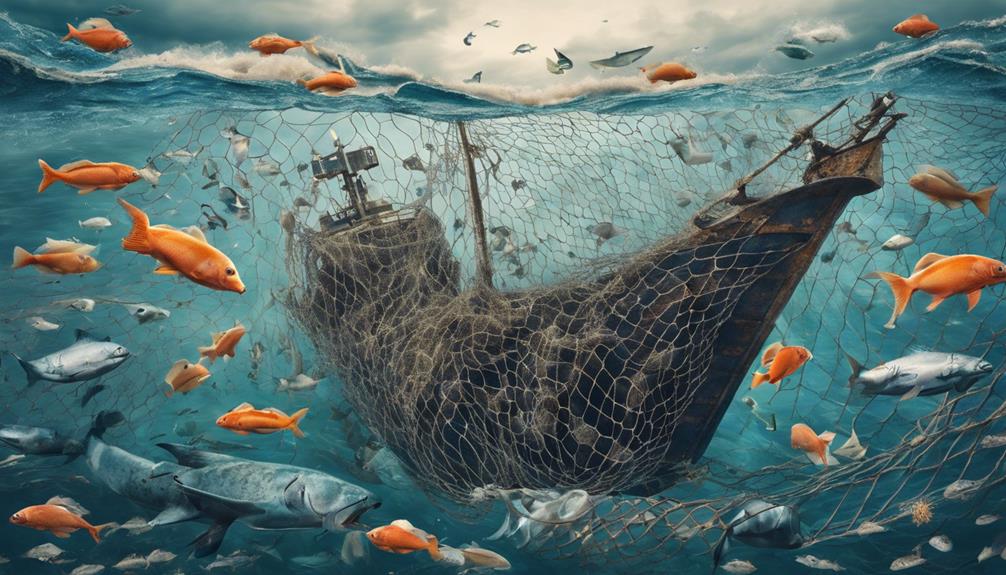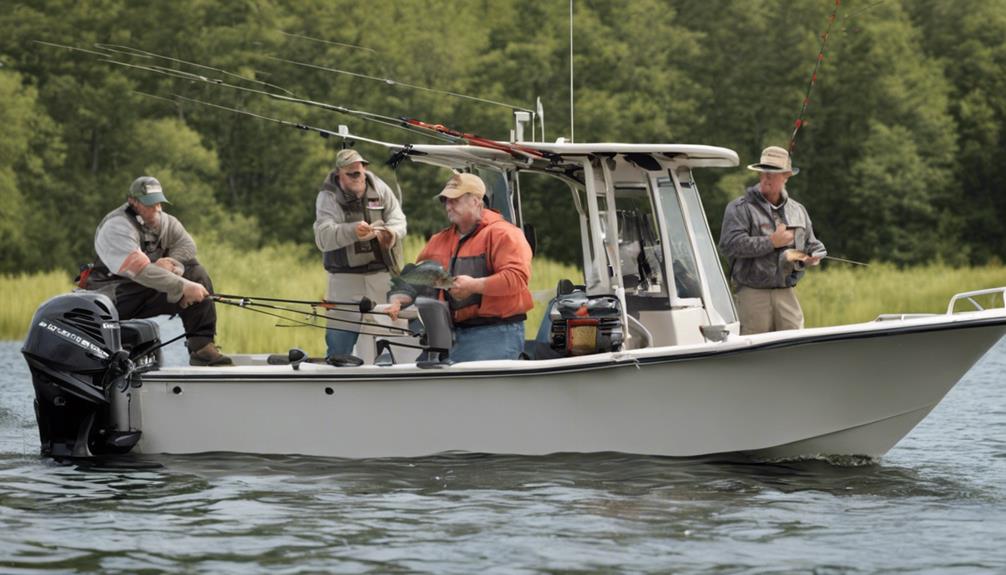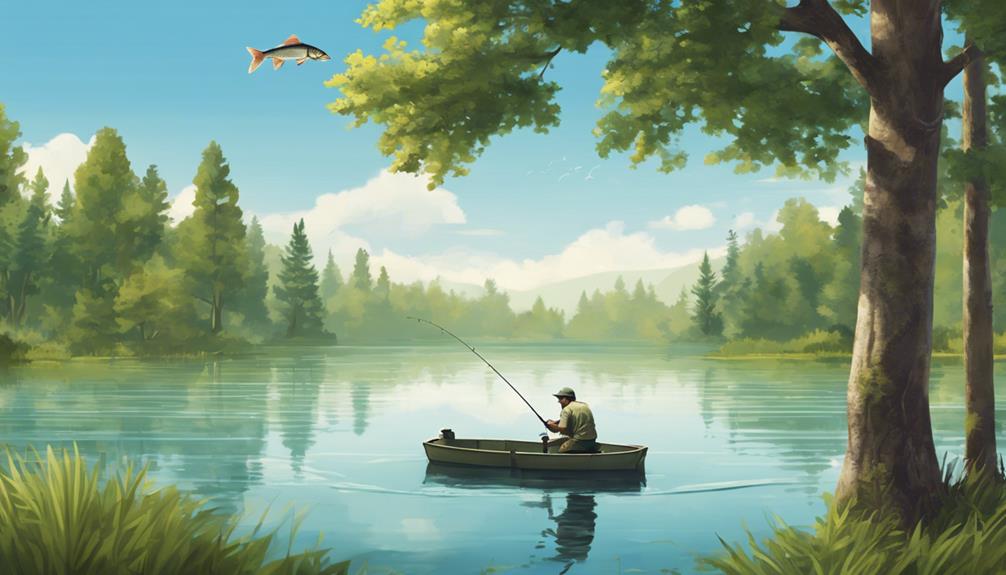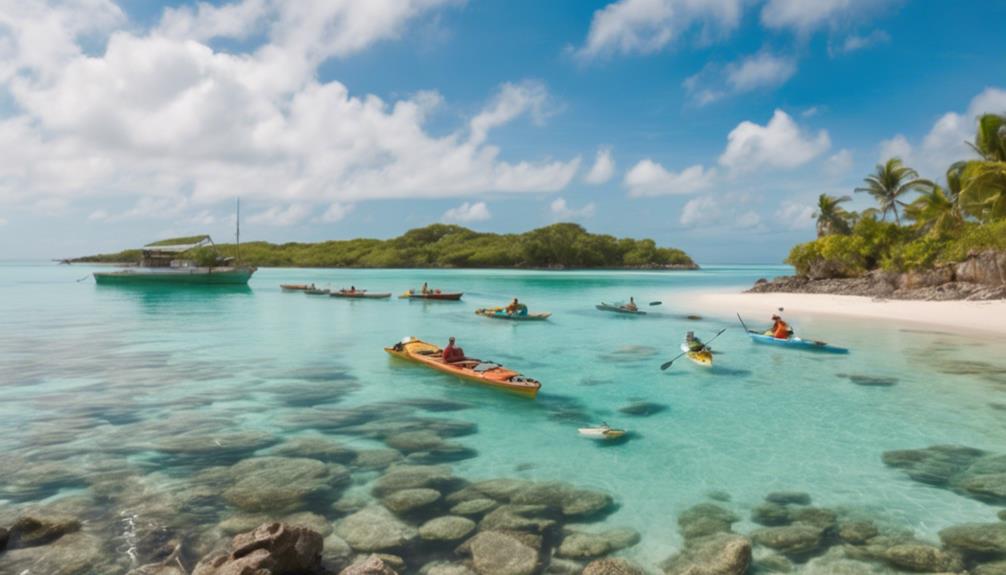You've probably heard the saying, 'You can't have your cake and eat it too.' When it comes to the intricate relationship between fishing practices and ocean conservation, this adage holds true.
The impact of fishing activities on marine ecosystems is multifaceted, encompassing issues such as overfishing, bycatch, and habitat destruction.
As you delve into the complexities of this topic, you'll discover the crucial need to strike a balance between meeting human needs and safeguarding the health of our oceans for future generations.
Overfishing Threats to Marine Ecosystems
Overfishing significantly depletes marine populations and disrupts the delicate balance of ocean ecosystems. This unsustainable practice poses a grave threat to the health of marine environments, impacting not only the fish species targeted but also entire ecosystems.
To mitigate these threats, the establishment of marine protected areas is crucial for safeguarding biodiversity and promoting ecosystem protection. These designated zones help conserve marine life by providing a safe haven where populations can thrive without the constant pressure of fishing activities.
Pollution impacts from overfishing further exacerbate the challenges faced by marine ecosystems. The excessive removal of fish disrupts food chains, leading to imbalances that ripple through the entire ecosystem. Additionally, habitat degradation caused by overfishing practices like bottom trawling destroys essential habitats such as coral reefs and seagrass beds. This destruction not only harms the species directly impacted but also diminishes the overall resilience of the ecosystem to external stressors.
Bycatch and Its Environmental Impact
The impact of bycatch on marine environments is a significant concern that warrants attention in ocean conservation efforts. Bycatch refers to the unintended capture of marine species during fishing operations. This issue not only threatens the sustainability of fish populations but also has detrimental effects on overall ecosystem health.
Marine species that are often caught as bycatch include sea turtles, dolphins, seabirds, and various fish species. To address this problem, bycatch reduction strategies are crucial. Implementing measures such as using circle hooks instead of J-hooks, employing devices to exclude non-target species, and modifying fishing gear can help minimize bycatch and protect vulnerable marine populations.
Conservation strategies aimed at reducing bycatch are essential for maintaining the delicate balance of marine ecosystems. By minimizing the unintentional capture of non-target species, we can help preserve biodiversity and ensure the long-term health of our oceans. It's imperative for fisheries to adopt sustainable practices that prioritize the protection of marine species and the overall ecosystem.
Importance of Sustainable Fishing Practices
To ensure the preservation of marine ecosystems and the long-term viability of fish stocks, adopting sustainable fishing practices is imperative. Marine stewardship plays a crucial role in maintaining the health of our oceans. By implementing responsible harvesting techniques, we can help protect vulnerable marine species and habitats from overexploitation and depletion. Sustainable fishing practices focus on minimizing environmental impact while still meeting the needs of present and future generations.
One key aspect of sustainable fishing is ensuring that fishing activities don't exceed the ocean's capacity to replenish fish populations. By setting catch limits based on scientific data and monitoring fishing efforts, we can prevent overfishing and promote the recovery of depleted fish stocks. Additionally, practicing selective fishing methods can help reduce bycatch and minimize harm to non-target species.
Engaging in sustainable fishing practices isn't only essential for the health of our oceans but also for the longevity of the fishing industry itself. By prioritizing responsible harvesting techniques, we can ensure the continued availability of seafood for consumption while safeguarding the delicate balance of marine ecosystems. It's our collective responsibility to act as stewards of the ocean, preserving its biodiversity and abundance for future generations to enjoy.
Depletion of Fish Stocks and Biodiversity
With the increasing demand for seafood, the depletion of fish stocks and loss of biodiversity in our oceans have become pressing concerns. Overfishing and unsustainable practices have led to a decline in various fish populations, disrupting the delicate balance of marine ecosystems.
- Effects of Overfishing:
- Overfishing reduces the population of certain species, causing imbalances in the food chain.
- It can lead to the collapse of fisheries, impacting the livelihoods of fishermen and coastal communities.
- Depleted fish stocks also affect marine predators and can result in cascading effects throughout the ecosystem.
To address these issues, effective fisheries management is crucial. Implementing sustainable fishing practices, such as setting catch limits and establishing marine protected areas, can help in the recovery of fish populations and the restoration of biodiversity in our oceans.
- Importance of Species Recovery:
- Species recovery programs aim to replenish populations of endangered fish species.
- By focusing on conservation efforts, it's possible to restore biodiversity and rebuild ecosystems.
- Collaborative initiatives involving governments, scientists, and local communities are essential for successful species recovery.
Role of Fishing Gear in Ocean Conservation
Considering sustainable fishing practices, selecting appropriate gear plays a pivotal role in ocean conservation efforts. Gear technology has a significant impact on the health of marine ecosystems. Conservation initiatives often focus on promoting the use of gear that minimizes bycatch, reduces habitat destruction, and targets specific species in a sustainable manner.
Modern advancements in gear technology have led to the development of more selective fishing methods. For example, innovations like circle hooks and turtle excluder devices help reduce unintended catch and protect vulnerable species. By using these tools, fishermen can target their desired species more accurately, minimizing the impact on non-target marine life.
Conservation initiatives worldwide are increasingly emphasizing the importance of gear selection in promoting sustainable fishing practices. By advocating for the use of gear that aligns with conservation goals, organizations and governments can help protect marine habitats and preserve biodiversity. Supporting research into gear modifications and promoting the adoption of sustainable gear practices are crucial steps in ensuring the long-term health of ocean ecosystems.
Ultimately, the role of fishing gear in ocean conservation can't be overstated. By embracing innovative gear technologies and supporting conservation initiatives that promote responsible fishing practices, individuals and industries can contribute to the preservation of our oceans for future generations.
Aquaculture's Influence on Marine Habitats
Aquaculture significantly impacts marine habitats by altering ecosystems and introducing new species. This practice, while crucial for meeting the growing demand for seafood, can have detrimental effects on the environment.
- Marine Pollution: Intensive aquaculture operations often lead to the release of excess nutrients, antibiotics, and pesticides into the surrounding waters. These pollutants can contribute to algal blooms, oxygen depletion, and overall degradation of water quality, impacting marine life and habitats.
- Habitat Alteration: Aquaculture facilities, such as fish farms and shrimp ponds, can modify coastlines and estuarine areas, disrupting natural habitats like mangroves and seagrass beds. This alteration can reduce biodiversity and affect the populations of species dependent on these habitats.
- Habitat Restoration: To mitigate the negative impact of aquaculture on marine habitats, efforts are being made to implement habitat restoration projects. These initiatives aim to rehabilitate damaged ecosystems, create artificial reefs, and establish protected areas to support biodiversity and enhance the resilience of marine habitats.
It is essential for aquaculture practices to evolve towards more sustainable methods that minimize environmental harm. By addressing issues such as marine pollution and promoting habitat restoration, aquaculture can play a more positive role in marine conservation and help ensure the long-term health of our oceans.
Regulations and Enforcement for Conservation
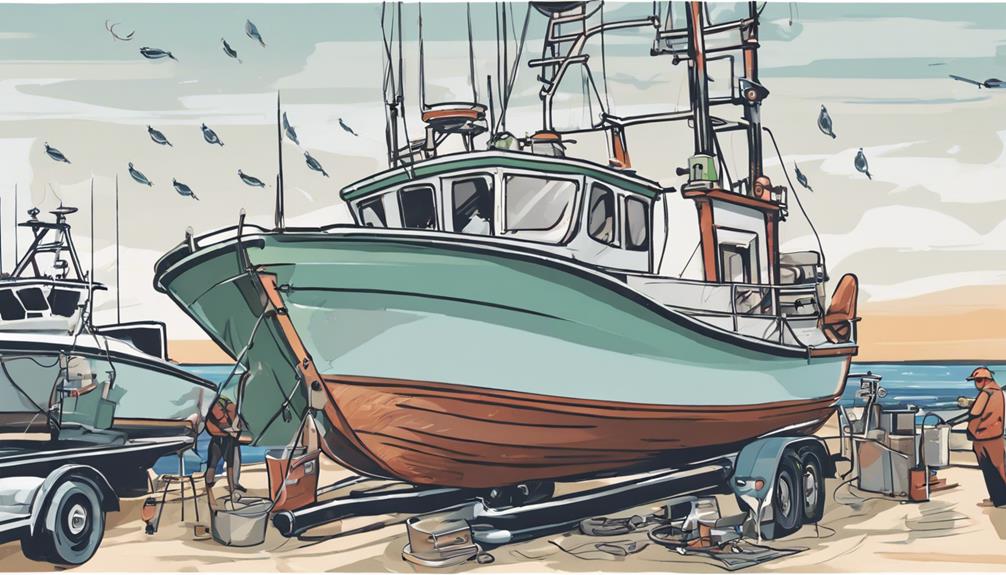
To effectively safeguard marine ecosystems and address the environmental impacts of aquaculture, strict regulations and robust enforcement mechanisms are crucial for conservation efforts. Regulatory compliance plays a significant role in ensuring that fishing activities are conducted sustainably and don't harm the delicate balance of ocean ecosystems. By adhering to regulations set forth by governing bodies, such as catch limits, size restrictions, and fishing gear regulations, fishermen can help minimize their impact on marine habitats.
Enforcement measures are essential to ensure that these regulations are followed. Monitoring fishing activities through satellite technology, onboard observers, and regular inspections can help detect and deter illegal or unsustainable practices. Penalties for non-compliance must be enforced consistently to discourage harmful behaviors and promote responsible fishing practices. Additionally, public awareness campaigns can educate fishermen and the general population about the importance of conservation and the role that regulatory compliance plays in preserving ocean health.
Collaborative Efforts for Healthy Oceans
In fostering healthy oceans, collaboration among stakeholders is key to implementing effective conservation measures. When it comes to ocean conservation, working together can lead to more impactful results.
Here are some ways collaborative efforts can contribute to the health of our oceans:
- Establishing Marine Protected Areas (MPAs): By working together, governments, conservation organizations, and local communities can designate and manage MPAs effectively. These areas help protect marine ecosystems, preserve biodiversity, and allow fish stocks to replenish.
- Promoting Community Engagement: Involving local communities in conservation efforts is crucial for long-term success. Communities that rely on the ocean for their livelihood can provide valuable insights, support enforcement efforts, and benefit directly from sustainable fishing practices.
- Sharing Resources and Expertise: Collaboration allows for the pooling of resources, knowledge, and technology. By sharing expertise and tools, stakeholders can maximize the impact of conservation initiatives and address challenges more effectively.
Frequently Asked Questions
How Does the Global Demand for Seafood Contribute to Overfishing Despite Conservation Efforts?
When the global demand for seafood rises, market pressures drive fishing fleets to catch more, often exceeding sustainable limits.
Despite government policies aiming to regulate fishing, the profitability of meeting demand can lead to overfishing.
Consumer education on choosing sustainable seafood and supporting fisheries with responsible practices can help alleviate this issue.
Embracing sustainable alternatives can reduce the strain on marine ecosystems and promote long-term ocean conservation goals.
What Are Some Lesser-Known Consequences of Bycatch on Marine Ecosystems?
When fishing, bycatch refers to unintentionally catching other species besides the target. This has serious unintended consequences on marine ecosystems, disrupting ecosystem balance.
Bycatch can lead to declines in populations of non-target species, affecting food webs and biodiversity. It also contributes to habitat destruction and alters predator-prey dynamics.
Understanding and addressing the impacts of bycatch is crucial for ocean conservation efforts.
How Do Climate Change and Pollution Exacerbate the Challenges of Sustainable Fishing Practices?
When it comes to sustainable fishing practices, climate change and pollution play a significant role. Coral bleaching affects fish habitats, making it harder for them to thrive.
Plastic pollution poses a threat to marine life, requiring innovative solutions for cleanup. These challenges make it crucial to adapt fishing methods to reduce environmental impact.
Can Genetic Engineering Play a Role in Replenishing Depleted Fish Stocks and Preserving Biodiversity?
Genetic modification can potentially aid in replenishing depleted fish stocks and preserving biodiversity. By utilizing advanced genetic engineering techniques, scientists can introduce beneficial traits into fish populations to enhance their resilience and reproductive success.
This innovative approach offers a promising solution to address the challenges of declining fish populations and promote sustainable fishing practices. With genetic modification, there's a unique opportunity to positively impact the conservation of ocean resources.
How Do Cultural Traditions and Practices Impact the Effectiveness of Regulations and Enforcement for Ocean Conservation Efforts?
Cultural traditions can greatly influence enforcement effectiveness in conservation efforts. Global demand for seafood often leads to overfishing, challenging regulations.
Some communities may prioritize traditional practices over conservation measures, hindering efforts. Understanding and respecting these traditions while promoting sustainable fishing practices is crucial for successful enforcement.
Balancing cultural heritage with the need for conservation is essential in addressing the impact of overfishing on ocean health.
Conclusion
In conclusion, understanding the impact of fishing on ocean conservation is crucial for protecting marine ecosystems. By implementing sustainable fishing practices, reducing bycatch, and enforcing regulations, we can help maintain healthy fish stocks and biodiversity.
It's important for everyone to work together towards a common goal of preserving our oceans for future generations to enjoy. Let's make a conscious effort to protect our oceans and ensure their longevity.
